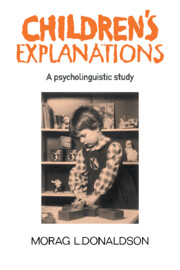Book contents
- Frontmatter
- Contents
- List of illustrations
- List of tables
- Acknowledgements
- 1 Introduction
- 2 The development of the causal connectives and of causality: some previous studies
- 3 Elicited production studies
- 4 The empirical mode
- 5 The intentional mode
- 6 The deductive mode
- 7 General discussion
- Appendices
- 1 Details of procedures for elicited production experiments
- 2 Sequences and items for Experiment 4
- 3 Stories and items used in Experiment 5
- 4 Materials used in Experiment 6 (Deductive/Empirical)
- 5 Acceptability judgement questionnaire based on Experiment 6
- 6 Materials used in Experiment 7 (Deductive Marking)
- Notes
- References
- Index
5 - The intentional mode
Published online by Cambridge University Press: 21 September 2009
- Frontmatter
- Contents
- List of illustrations
- List of tables
- Acknowledgements
- 1 Introduction
- 2 The development of the causal connectives and of causality: some previous studies
- 3 Elicited production studies
- 4 The empirical mode
- 5 The intentional mode
- 6 The deductive mode
- 7 General discussion
- Appendices
- 1 Details of procedures for elicited production experiments
- 2 Sequences and items for Experiment 4
- 3 Stories and items used in Experiment 5
- 4 Materials used in Experiment 6 (Deductive/Empirical)
- 5 Acceptability judgement questionnaire based on Experiment 6
- 6 Materials used in Experiment 7 (Deductive Marking)
- Notes
- References
- Index
Summary
Introduction
Explanations in the intentional mode
Most of the studies on the development of the causal connectives which are reported in the literature have dealt exclusively with the empirical mode. In Chapter 4, we saw that young children are much more competent at dealing with because and so in the empirical mode than the results of most previous experiments have suggested. We shall now turn to the question of whether young children's ability extends to the intentional mode or whether it is initially restricted to the empirical mode.
In the intentional mode, an action is explained in terms of the agent's aim or intention. The action is viewed as a goal-directed and purposive element of behaviour. Therefore, an intentional explanation includes a reference to an event or state which occurs (or is expected to occur) after the action which is being explained. In this sense, intentional explanations are ‘forward-looking’, whereas empirical explanations are ‘backward-looking’ (in that they explain an event/state in terms of a temporally prior event/state).
When a speaker gives an intentional explanation, he asserts that a psychological relation holds between the action and the intention. At the same time, he presupposes that the action is likely to achieve the intended result. The relation between the action and the result may be causal, as in:
(5.1) John wound up the toy car because he wanted it to go.
In some cases, though, the action does not actually cause the event/state which the agent intends to bring about.
- Type
- Chapter
- Information
- Children's ExplanationsA Psycholinguistic Study, pp. 83 - 103Publisher: Cambridge University PressPrint publication year: 1986

